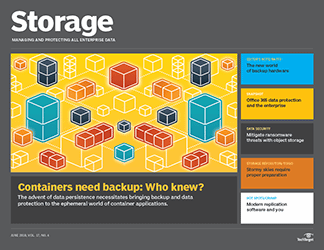PRO+ Premium Content/Storage
Access your Pro+ Content below.
What's new with data protection systems? Everything

This article is part of the Storage issue of June 2018, Vol. 17, No. 4
How did buying backup hardware get interesting again in this age of software-defined storage and the cloud? Actually, it's the software and the cloud that made data protection systems more interesting than they have been in years. The hardware hasn't changed much since the early 2000s, when disk supplanted tape as the mainstream backup medium. Even the rise of flash in primary storage hasn't changed the hard disk's role in data protection systems. But the game has changed for buying data protection systems, including the role of the hardware. Led by newcomers Cohesity and Rubrik, the targeted uses have expanded. Backup is now just a piece of secondary storage management, and the target includes the cloud as well as an on-premises disk appliance or library. There's a good chance your next backup hardware will come with backup software integrated instead of sold separately. That alone changes the buying dynamic. It may simplify the buying and integration processes, but it complicates the decision-making. How we got here Rubrik (...
Features in this issue
-
Container backup follows data persistence to these ephemeral apps
The advent of data persistence in containers necessitates having data backup in containers. Here's how this is being done and which vendors are leading the way.
-
Office 365 data protection, the enterprise and you
Gain a better understanding of Microsoft Office 365 security and storage management features and how the popular cloud-based productivity and collaboration suite really works.
Columns in this issue
-
What's new with data protection systems? Everything
The next backup hardware you purchase will likely come with integrated backup software. That changes the buying dynamic and complicates the decision-making process.
-
Disaster avoidance requirements ensure business continuity
Include disaster recovery and avoidance requirements as design goals when creating storage and production environments to ensure business continuity during weather events.
